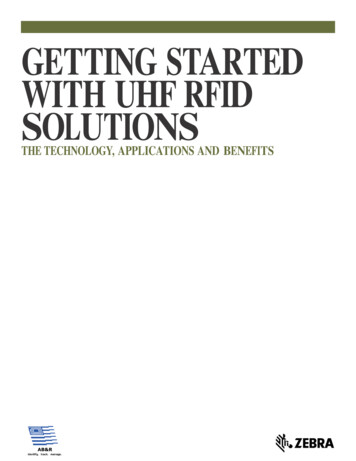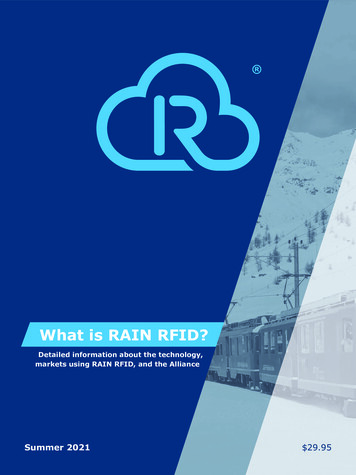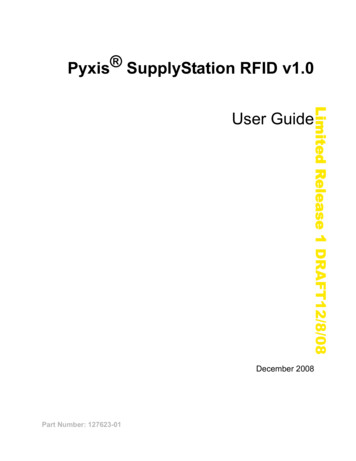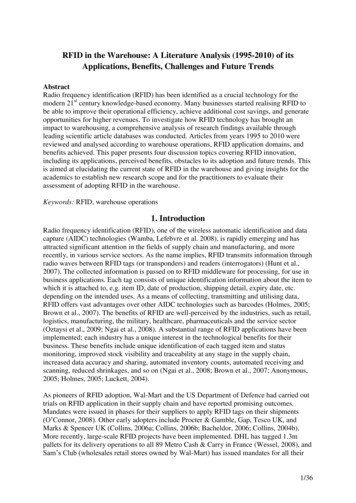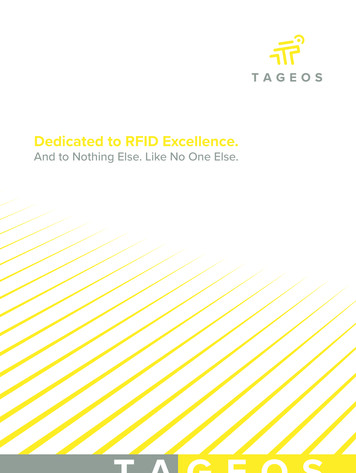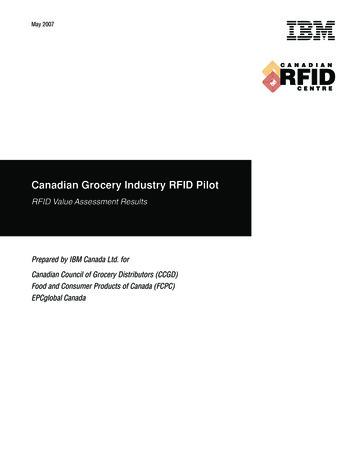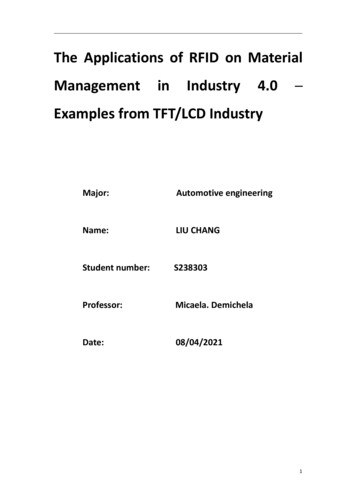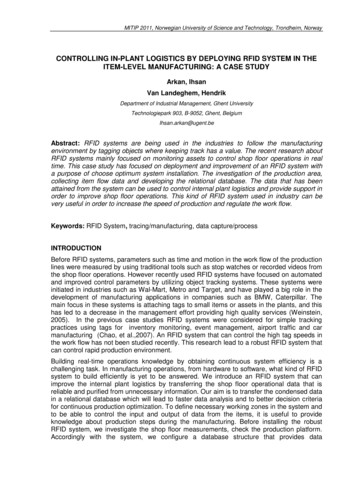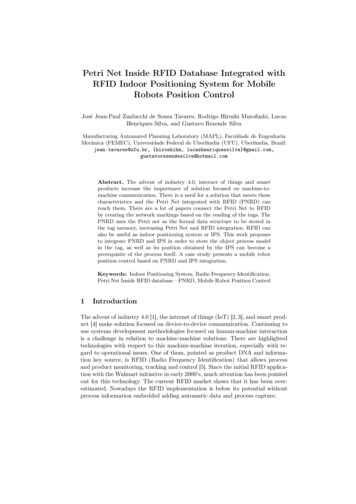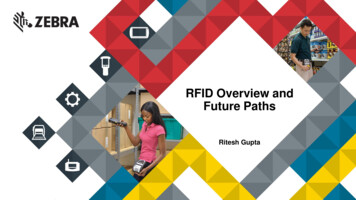
Transcription
Department of Innovation,Design and Product developmentAnalysis of Implementation of RFIDTechnology in Retail IndustryKPP231 Master Thesis work30 credits, D-levelProduct and process development,Master Thesis Programme in Production, Logistics and RoboticsAuthorsMostafa AljawaheriSyed Muhammad Waqar AzeemReport code:Commissioned by: Mälardalen UniversityTutor (company): Emil EngströmTutor (university): Sabah AudoExaminer: Sabah Audo1
SummaryIn today’s world cost optimization and better service are becoming the essential components ofthe retail supply chain. The thesis tries to contribute to the understanding of the RFIDtechnology in the retail industry. The basic concepts and the research contribution of the variousauthors are briefed in the theoretical framework made for a better understanding to the readers.After gained the relevant theoretical knowledge, the interviews were conducted with the RFIDexpert and some retailers. The empirical data collected from the interviews and surveys areprojected. With the empirical results and the relevant theoretical results, an analysis is madewhich explicitly gives the basis of implementation of RFID in the retail supply chain and itsassociated practical scenarios. Another outcome of the thesis is the result of the checkoutanalysis of the Willys retail store, and researchers try to show the potential benefit of adoptingthe RFID technology at item level at the point of sales, also cost estimation and savings areshown in the analysis. In a bird’s eye view, this research thesis work is a contribution to theimplementation of RFID technology in the retail industry and its integration among the differententities of retail supply chain and improves the overall performance of supply chain and providea framework for RFID implementation for the case company.2
3
TABLE OF CONTENTSList of Figures . 6List of Tables . .81. INTRODUCTION . .91.1 Background . 91.2 Thesis Objectives . .111.3 Research Goals . .111.3.1 First goal . .111.3.2 Second goal . .111.4 Project Limitations . .121.5 Thesis Report Structure . . .132. RESEARCH METHODOLOGY . .142.1 Research Methods . 142.2 Research Approach . .142.2.1 Quantitative Research .142.2.2 Qualitative Research 152.3 Literature Review . . .152.4 Interview Preparations . 162.5 Questionnaire Preparation . .162.6 Conducting interviews .163. THEORETICAL FRAMEWORK . . .173.1 Barcode Technology .173.2 RFID Technology .183.2.1 What is RFID?.183.2.2 RFID History . .193.2.3 RFID Working Principle . 203.2.4 Research in RFID . 233.2.5 RFID in Sweden .243.3 Supply Chain Management . .253.3.1 Definition . .253.3.2 Retail Supply Chain . 253.3.3 RFID in Retail Supply Chain . .263.3.4 RFID Benefits . .283.3.4.1 Retailer Benefits . . .283.3.4.2 Consumer Benefits . .283.3.5 RFID Implementation Challenges . 293.4 Queuing Theory 313.4.1 Queuing Process . .313.4.2 Queuing Models parameters . .333.4.3 Notations for Queuing models 333.4.4 Queuing cost .344
4.5.6.7.8.3.4.5 Use of Simulation in queuing models .353.5 Investment Assessment .363.5.1 Investment calculations .36EMPIRICAL RESULTS .374.1 Findings through Interviews 374.1.1 Retail supply chain with RFID . 384.1.2 Implementation level of RFID in retail industry .384.1.3 Factors affecting the implementation of RFID .394.1.4 Issues in implementing RFID .404.2 Finding through Survey Questionnaires . 41ANALYSIS AND RESULTS .455.1 Implementation of RFID technology in the Retail Supply Chain 455.1.1 Benefits of RFID over barcode technology . .455.1.2 Usage of RFID in retail supply chain . 465.1.3 Conditions for implementing RFID in retail industry. 475.2 Analysis of Point of Sales service in Willys .505.2.1 Queuing Calculations . .505.2.2 Queuing cost estimation .545.3 Cost Analysis of implementing RFID at POS in Willys 555.4 Overview of implementing RFID at POS in Willys . . 56CONCLUSIONS AND FURTHER STUDY .586.1 Conclusions 586.2 Further Study 59REFERENCES 60APPENDIX .658.1 Appendix I. .658.2 Appendix II 668.3 Appendix III .678.4 Appendix IV .728.5 Appendix V 745
List of FiguresFigure 1 Thesis Report StructureFigure 2 EAN 13 Barcode (Source: Gray, 2009)Figure 3 Different types of RFID Tags (Source: Nearfield, 2012)Figure 4, 5 Radar and Microprocessor technologies (Source: Shyshkin 2010 & Gangar 2009)Figure 6 Components of RFID system (Source: Jesic, 2008)Figure 7 Communications between Reader and Tag (Source: Reversesecurity, 2009)Figure 8 Different types of RFID readers (Source: Cisco, 2011)Figure 9 Example of an EPC global product code (Source: Hodder, 2003)Figure 10 Retail Supply Chain EntitiesFigure 11 single queue with single server, Model 1 (Source: Babbar, 1996)Figure 12 Single queue with multiple servers, Model 2 (Source: Babbar, 1996)Figure 13 Multiple queues with multiple servers, Model 3 (Source: Babbar, 1996)Figure 14 Graph showing the cost of queuing (Source: Operation research, 2009)Figure 15 Key drivers for implementing RFID in Retail industryFigure 16 RFID vs. Barcode TechnologyFigure 17 Largest cost item in adopting RFIDFigure 18 Compelling reasons to adopt RFIDFigure 19 Key hindrances in implementing RFIDFigure 20 Affects of RFID on business processesFigure 21 Expected benefits from RFID adoptionFigure 22 Generic retail layoutFigure 23 RFID usages in different areas of retail supply chain (Source: Bhattacharya, 2007)Figure 24 Necessary conditions for applying RFIDFigure 25 RFID Network in retail industryFigure 26 Customers in Checkout Queue6
Figure 27 Graph showing the total cost of waiting in the queuesFigure 28 Possible changes in the Point of Sales of Willys Erikslund7
List of TablesTable 1 Comparison of RFID and Barcode (Source: Hunt, 2007)Table 2 Elements of integrated retail supply chain (Source: Vargas, 2007)Table 3 Challenges in implementing RFID (Source: Mohsen, 2012)Table 4 Sub-processes of queuing modelTable 5 List of Individuals interviewedTable 6 Total waiting cost estimation with using different number of serversTable 7 Queuing results for Model-1Table 8 Queuing results for Model-2Table 9 Queuing results for Model-3Table 10 Cost investment and savings8
1 INTRODUCTIONThe first chapter of the thesis starts with introducing the background of thesis project. Following thisthe objective and research goals in the thesis work are presented and the delimitation at the end of thechapter1.1 BackgroundImagine, you are standing in front of your cabinet and thinking that one of your cardigans isquite worn off. With the help of your electronic advisor with touch-screen function built insideyour cabinet you can see when you actually bought that cardigan. You have found that yourcardigan is already about couple of years old, also you can find it already has lost 30% of itsoriginal color. With the help of your electronic advisor you search the same new product in yourfavorite stores or on the internet. You select some of the cardigans and order the stores to makethose ones available for fitting in the store supposing you don‟t like to order clothes throughinternet.When you visit the store, you are welcomed by the big TV-screen without even showing youridentity and loyalty cards. It automatically says your name and also informs you about some newoffers as well that might you are interesting in and guide you the way to your ordered clothes. Asmall PDA (Personal Digital Advice) device attached to your shopping cart shows you thedirections to the particular shelves. While trying some cardigans you can see information such assource of the wool, where and when was it produced and its expected life without losing itsoriginal color. After selecting one cardigan, the TV-screen shows offers to you of other productssuch as pants, shirts and socks that you would like to combine with you selected cardigan. It alsoinforms you about some discounts if you combine it with the pants offered.When you passed the check-out gate, a screen displays the clothes you bought and your IDverified automatically by the system and pay for the clothes with just one touch on the screen.Before taking on the clothes for the very first time, you want to have it washed so you put it intothe washing machine which immediately recognizes the suitable washing temperature andquantity of detergent required for washing. All above mentioned looks bit strange but all couldbe possible with one technology, RFID. We don‟t know exactly know all mentioned above willcome true one day, only time will show which applications will be wanted and accepted by thepublic. Still it‟s not clear how RFID will change our everyday life, but there is one thing we cansaid with certainty: RFID cannot be stopped anymore. “There is nothing permanent except thechange”.In this thesis work the authors have addressed the important issues related to the next big thing inworldwide retail and distribution, the RFID. RFID is a technology for tracking and information9
which has existed for over 50 years, and Charles Walton from United States is considered as thefather of RFID (Takahashi, 2004), his work during the seventies is a basis for today‟s RFIDtechnology. Here arises the valid argument that why we do not have RFID in wide use as it wasinvented long back in 1970‟s? Apart from Charles Walton and other scientists efforts for RFID,during that time the technology was not enough advanced to use RFID on commercial basisfeasibly. It is only now possible with more development in electronic and microchip technologyto produce small RFID components, cheap and useful in sizeable levels.Radio frequency identification (RFID) is a generic term, used to define a transmitting systemthat identifies the object or person wirelessly, by means of radio waves. In mainstreamapplications RFID is becoming the key technology that help speed the handling of manufacturedgoods and material by the technology achievement in communications and microelectronics.RFID identifies the object from a distance, unlike barcode technology‟s line of sightrequirement. Uses of RFID technology can be found in several application areas such as supplychain management, security, access control, etc. RFID system consists of three primarycomponents: a transponder (tag), a transceiver (reader) and a data collection device.In today‟s world, with heavily growing demand in the retail industry, there is an urge for materialavailability, service and increasing competition. Due to increased speed in goods flow, greaterlevels of automation and ever decreasing price and size of tags the importance and relevance ofRFID technology in worldwide logistics is substantial. Actually this is the functionality of RFIDthat destined it to replace barcode soon. Also the Global competition between the retail storeshave forced the stores to rethink how they should provide the appropriate service to thecustomers to sustain their place in the market.Radio frequency identification technology has numerous potential applications andaccompanying technologies, and it depicts a subsequent incremental stage shift towardsimprovements in retail business. Number of authors agreed that RFID has a bright future in theretail industry as a replacement of barcode. Projects executed by the likes of Wal-Mart, Gillette,Tesco and Procter & Gamble, etc shows admirable results and researches compared to currentscenarios lead us to believe that RFID implementation will drive us towards great changes infuture.10
1.2 Thesis ObjectivesWillys is a chain of retail stores that, like many other retailers in Sweden want to investigate thepossibilities of using RFID in its various supply chain processes to enable a better and profitableflow of materials. After making contact with one of Willys store in Västerås (Erikslund), it wasdecided by the researchers to work on the basis for RFID implementation for Willys Sweden.(Kambil, 2002) argues that the problem with RFID is that implementations are relatively costlyand that the actual efficiency improvements are often qualitative and therefore difficult todirectly measure the financial values. Still it is beginning of RFID in Sweden retail market; thisresearch shows generic results concluding the results after conducting interviews with theconsultants in RFID and survey.This research concentrates on the issues related to the implementation of RFID in retail market,possible benefits of RFID over barcode technology, hindrances in the implementation, maindrivers, potential benefits of RFID both for the retailer and consumer sides, the current status ofRFID in retail industry and also try to address the development and analysis of future scenarioswhere RFID technology can be used.Also considering the item level tagging in Willys, for the sake of showing benefits from bothretailer and consumer scope queuing analysis has done, which played an important role incalculating the payback period and costing. Conventionally in retail stores customers have towait in the queue for checking out, we used queuing models to highlight the potential benefit ofimplementing RFID technology at the point of sales (POS).1.3 Research Goals1.3.1 First goal: Implementation of RFID technology in the Retail Supply ChainIn accordance to the thesis objective and to fore see a determined path to fulfill the objective,several research questions were framed. Also the research questions give a chance to know aboutthe structure of the research work covered in the thesis.-Why RFID is better than barcodes?-Current status of RFID implementation in retail industry.-Cost and benefits allocation among the retail supply chain.-What are the major drivers for adopting RFID in retail supply chain?11
-Area where RFID can be used in retail supply chain?-What are the challenges faced in adopting RFID in retail industry?1.3.2 Second goal: Evaluate the usage of RFID at Point of Sales (POS) in Willys Erikslundwith the help of Queuing Theory.1.4 Project LimitationsRFID usage in retail industry is an emerging area and hence not many research works could befound which integrates the stores supply chain. In our project we limit our scope to the retailsection of RFID implementation, the field of RFID is very deep and demanding and there is a lotof potential in it. We have not work on the coding aspect of RFID as it doesn‟t come under ourarea of work. The thesis has broader scope since we interviewed some representatives from LidlKB, Ericsson Sweden. This is because the project initially started considering Willys inErikslund was planned to have an in-depth study in supply chain but due to some permissionissues we restrict it to the queuing calculations in Willys Erikslund. The interviews were carriedout with people in relevant are to be possible extent. Also this research is kind of basics for pilotproject for Willys; if Willys will ask us do more in future we can continue our work onimplementing the RFID technology in Willys.Research intention is to provide guidelines and general ideas about defined questions.Addressing all the possible situations and problems is not the intention of this research. Resultsshown by our research should be considered in research context and used as described in thechapters. Queuing and cost analysis should also be considered as a helping tool and not asperfect decision making tool.12
1.5 Thesis Report StructureThis thesis will be organized as follow:Figure 1 Thesis Structure13
2 RESEARCH METHODOLOGYThis chapter is written to present the research methodology that has been used to achieve the purposeof this thesis. Literature review of the thesis, the interview preparation and conducting of interviewsare presented in this chapter.2.1 Research MethodsResearch is the systematic investigation of existing or new knowledge. It is used to establish orconfirm facts, reaffirm the results of previous work, solve new or existing problems, supporttheorems, or develop new theories. (Sagar, 1999)The first step is to present the situation in a specific research area and from there to find aproblem that is relevant to investigate. The problem is something to be solved, illuminated orsimply something where there is an interest to expand knowledge. The problem is formulated sothat it leads to a general purpose describes what the study aims to achieve. The aim was tobroadly examine how to implement the RFID technology in retail industry. The aim was thenbroken down to more specific questions. Furthermore, to determine the direction and limitationsof the thesis previous studies analyzed and compared with the actual subject of the inquiry.2.2 Research ApproachIn every research, researchers need to decide which cognitive tool to use to help themselves inbetter understanding unknown and answering their research questions. Yin (2002) and Leedy(2000), define several different categories of research; descriptive, explanatory, exploratory,qualitative, quantitative, etc. In our research we chose both quantitative and qualitative methodas per our requirements i.e., answering our research questions by analysis of different articles,conducting interviews and surveys and justifying our work by doing queuing calculation with thehelp of empirical data provided by the case company.2.2.1 Quantitative ResearchQuantitative research is based on empirical data and present numerical results; hence theypossess high validity and creditability. Quantitative research is able to answer questions relatedto “how many” and “how much”. According to Creswell (2002), quantitative approach is usefulwhen attempting to test an explanation or identifying factors that influence results.14
2.2.2 Qualitative ResearchThis research is more subjective and interpretive. According to Patton (1990), qualitative dataare detailed description of situations, events, people, interactions, observed behaviors, directquotations from people about their experiences, beliefs and case histories. Creswell (2002) alsosays that qualitative research is suitable for researching a phenomenon in that area research hasnot been done extensively. Many authors agree that both approaches can be combined in manyinstances.Furthermore, Leedy (2000) explains, descriptive studies involve either identifying thecharacteristics of an observed phenomenon or exploring possible correlations among two ormore phenomena. For exploratory research, Yin (2002) state that exploratory studies seek torealize and clarify what is happening with the intension of developing new hypotheses andtheories. Explanatory research aims to explain the research problem in greater detail and ismainly related to why and how questions.2.3 Literature ReviewLiterature review is an analysis of the research work done in a specific domain. According tohart (1998), literature review is the selection of available documents on the topic, which containsinformation, ideas, data and evidence. This selection is written from a particular standpoint tofulfill certain aims or express certain views on the nature of the topic and how it is to beinvestigated, and the effective evaluation of these documents in relation to the research is beingproposed” (Hart, 1998).Purpose:The purpose of literature review is to manifest the scholarly ability to discover the relevantinformation for the scope of the work, build a supportive theoretical framework for the subject,defining the key words, definitions and terminologies, identifying previous research works and torationalize the research topic.Writing a review:The writing starts with identifying the research questions followed by analyzing and locating theneeded information. According to Hart (1998) the first step should be writing a draft consideringthe expectation and the needs of the readers. Next step is reworking the draft, considering aboutclarity and structure of the paper until obtaining a final draft. Finally, check the grammar andspelling, the literature review is done.Before framing the interview questions a deep study has been performed within the research areaof RFID, supply chain and retail industry along with the connected relevant literature. This studywas performed to get a better understanding about the concept and also to make the discussionsmore interesting and interactive during the interviews.15
2.4 Interview PreparationsThe questions forms were designed according to the type of representative to be interviewed.Two types of questions forms were prepared in context of RFID and retail supply chain. Themain objective of the question forms prepared is to know what are the perspectives of retailers inthe field of RFID.2.5 Questionnaire PreparationThe questions for the questionnaire were formulated in accordance to the objective of the thesis.The main requirement for questionnaire is to reduce the interview duration and to make theinterview sessions easier and with better conclusive understanding. The questions framed haverelevancy with the research questions stated. Some of the questions were given with multiplechoices, some with rating (agree, somehow agree, and disagree) and respondents were alsoprovided with an option of answering on their own. The interview and survey questions areavailable in Appendix section.2.6 Conducting the interviewsInterview is the most common used method in qualitative research. Bryman (2001) mentionedmany types of interview such as open interview, standardized interview, semi structuredinterview and so on. But most common types of interview are structured, semi-structured andunstructured (Bryman, 2001).In this thesis work, the researchers have used semi-structured interview. Bryman (2001) definedthat “Semi-structured interview is a term that covers a wide range of instances. It typically refersto a context in which the interview schedule but is able to vary the sequence of questions. Thequestions are frequently somewhat more general in their frame of reference from that typicallyfound in a structured interview schedule. Also, the interviewers usually have some latitude to askfurther questions in response to what are seen as significant replies”.16
3 THEORETICAL FRAMEWORKThis chapter explains the fundamentals of RFID such as history, origin, function, uses and relatedresearch. The chapter also includes the introduction of retail supply chain and queuing theory for thesake of investment decisions on RFID systems.3.1 Barcode TechnologyAutomatic identification is used to identify people, animals, goods and products in motion(Finkenzeller, 2003). There are various techniques used for identifying in different applicationareas, including smart cards, optical character recognition (OCR) and biometric identificationmethods such as voice recognition. In this group RFID and the most widely used technology inthe category bar codes are also included. Bar codes are popular because they are cheap and easyto use. Disadvantages and limitations however, meant that alternatives have been developed tomeet the higher standards of transparency and security in a variety of applications.Bar codes are composed of a binary code represented by different thicknesses of the black linesgap of variable size which is read by an optical laser directed toward the bar code and reflectionof the laser determines the tagged object's identity (Finkenzeller, 2003). There are different typesof bar codes based on different standards but the most common is the EAN (European ArticleNumber), which consists of a set of numbers in a range of numbers. The most common standardthe number ranges is EAN 13 (i.e. 13 digits of the serial) and it contains information aboutcountry of origin, company, manufacturer's part number and a final check digit. In the UnitedStates they use standard UPC (Universal Product Code) and then EAN is a development of theUPC, it has become subordinate EAN standards and are compatible with each other (Hunt,2007). Advantages with the technique include that it is cheap and easy. Disadvantages are thatthe bar codes can hold some information must be read one by one and convenient and they donot work when they are dirty (Finkenzeller, 2003).Figure 2 EAN 13 Barcode (Source: Gray, 2009)17
3.2 RFID Technology3.2.1 What is RFID?RFID stands for Radio Frequency Identification and refers to the transfer of information viaRadio frequency (Finkenzeller, 2003). RFID system uses wireless radio communicationtechnology to identify tagged objects or people. The three basic components of RFID system are:-Tag: Sometimes called a transponder and composed of a semiconductor chip and anantenna.-Reader: Also known as an interrogator, and composed of an antenna, RF electronic module,and a control electronic module.-Controller: Also known as a host, which most often takes in form of a PC running databaseand control.The technique has many applications such as tracking of goods, automatic duty stations, theidentification of newborns, the card to open doors or pay for public transport etc (Hunt, 2007).RFID is compared mostly with barcodes because they both can be used in similar ways and inmany similar areas, though RFID is a more advanced technology. An example of the differencesis that an RFID reader can identify a large number of objects around the same time whilebarcodes can only be identified one by one.A bar code must be placed visible just in front of the reader to be read while an RFID tagging or"tag" can be read at long distances away, through most materials and for a higher speed andprecision. The disadvantages are that there are many different standards, implementation of anRFID system is complex and it is more expensive in the current situation (Banks, 2007).Figure 3 Different types of RFID Tags (Source: Nearfield, 2012)18
DataReadabilityImplementationCostSafetyRFIDLarge amountMany can be read at once,they can be read at longdistances, even if they aredirty and made by variousmaterials.More complicatedHigher per tagDifficult to access data,almost impossible to copyand changeBarcodeSmall amountOne read at a time, they mustbe visible, clean andundamaged.EasyVery cheapVery easy to read andpossible to copy or changeTable 1 Comparison of RFID and Barcode (Source: Hunt, 2007)3.2.2 RFID HistoryThe technology behind RFID did not have a precise moment in history, and grew up with using avariety of other technologies and research. It started with a better understanding ofelectromagnetic energy in the late 1800s that led to the development of radio communicationsand radar systems (Hunt, 2007). The radar system was an anti-collision system (More signals canbe read and receive simultaneously) and its use during World War II for identifying the enemiescan be considered the first RFID use. The invention of the transistor in 1947 led to smaller andcheaper components could be manufactured and that is what makes RFID tags become cheaperevery year.Harry Stockman in 1948, invented how the radio waves could be sent away to a receiver, alsopower supply helped to send a signal back and that was the basis for today's passive RFID tags(Banks, 2007). Further research in radio frequency technologies led to several inquiries regardingapplications and at the end of the 60s, RFID used for the very first time commercially (Hunt,2007). A major problem with RFID was the size of the tags, but this began to change in 1971when the first microprocessor came and then the tags could be smaller and more sophisticated.However, it was in the 1980s as the commercial uses of RFID increased and included key fobs,access cards, cattle marking, and some applications in rail transport.1990 onwards came with a lot of RFID use, fairly due to IT technology had evolved so much andthat there were opportunities to put together the network and manage information in a better way.But still material costs and lake of standards prevented the technology to have a greater impactthan.19
The prices of RFID was reached relatively low levels began in the 2000s and then RFID couldactually replace bar codes in the long run. The U.S. armed forces and Wal-Mart have since themid-2000s had raised the demands of its suppliers using RFID, but the complexity and cost isstill an obstacle for many suppliers (Hunt, 2007).Figure 4, 5 Rada
Figure 15 Key drivers for implementing RFID in Retail industry Figure 16 RFID vs. Barcode Technology Figure 17 Largest cost item in adopting RFID Figure 18 Compelling reasons to adopt RFID Figure 19 Key hindrances in implementing RFID Figure 20 Affects of RFID on business processes Figure 21 Expected benefits from RFID adoption
